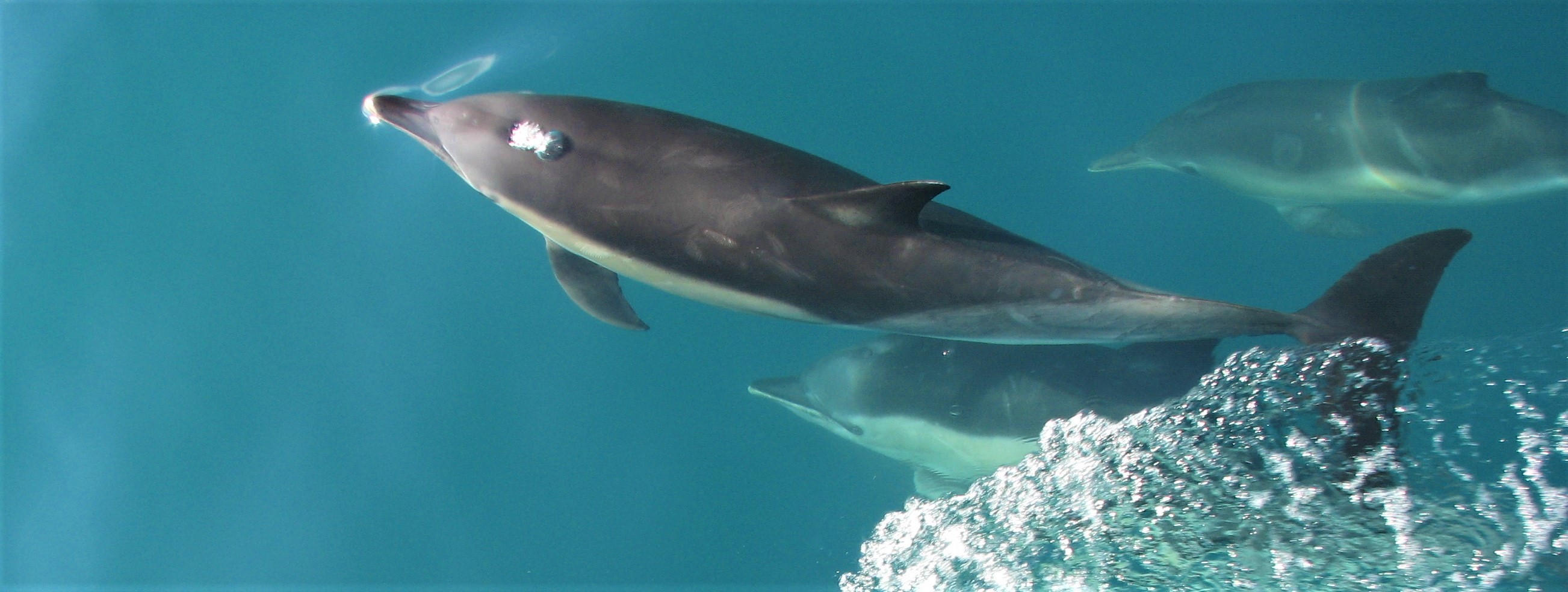- Order:Cetacea
- Suborder:Odontoceti
- Family:Delphinidae
- Genus:Delphinus
- Species:Delphinus delphis (Linnaeus, 1758)
Identification
The most striking feature of the common dolphin (Delphinus delphis) is its characteristic hourglass patterning on the lateral flanks - created by overlapping of the contrasting dorsal and ventral patches to form a "V"-shaped saddle below the dorsal fin. This overlapping results in a greyish green or bronze tan colouration of the thoracic patch on each side of the animal. The body is fusiform and streamlined, and the animals long, narrow rostrum forms a sharp angle between the beak and forehead. The dorsal fin is tall and falcate and the fins taper to a pointed tip. The tail flukes are concave with a distinctive median notch on the rear margin.
The well-defined beak of the common dolphin is generally black but often tipped with white. The dorsal fin colour ranges from all black, to mostly white with a dark border, and there is often a greyish area in the middle of an otherwise dark fin. The flippers and flukes are dark grey to black, but in the eastern North Atlantic the flippers are commonly pale / light grey to white. Sexual dimorphism is apparent in the colouration of the areas around the genitals, with males exhibiting a distinctive black blaze above the genital opening and females having a narrower band of black with grey counter-shading.
More than 20 species of Delphinus delphis have been proposed because of the great variation in appearance. However, the two species currently recognised are the short-beaked (D. delphis) and long-beaked (D. capensis) forms.
Distribution & Habitat
The common dolphin may be one of the most widely distributed species of cetacean since it is found world-wide in temperate, tropical and sub-tropical seas. These are pelagic, offshore dolphins that are most likely to be encountered along (or seaward of) the continental shelf, although they do occur close to shore in some areas. Distribution has been reported to correlate with water temperature and bottom topography (such as prominent underwater features including sea mounts and escarpments). They apparently prefer water temperatures ranging from 10 to 28 degrees centigrade.
The long-beaked form is mainly found in the Gulf of California or western Baja California, and there is possibly a population of this type in the eastern South Pacific. Other studies have documented their presence in Japan, Korea and China. There are also local forms recognised in the Mediterranean, Black Sea, Indian Ocean and both European and African Atlantic coasts.
Well-defined migrations are not known, and common dolphins are present year round in some parts of their range. In some locations, seasonal shifts in distribution are observed (e.g. in Southern California where peaks of abundance are observed in June, September to October, and January). Seasonal shifts also occur off the British Isles, and it is thought that movements may be correlated with shifting prey distribution and abundance.
Natural History & Ecology
Common dolphins may reach up to 2.6 m in length, and weigh over 130 kg, although most adults are less than 2.3 m long and weigh around 80 kg. Males tend to be slightly larger than females, and mean body lengths may vary geographically. Length at sexual maturity subsequently varies geographically, but is generally reached at 150 to 180 cm and at 3 years of age in males, and 150 to 200 cm and 5 to 7 years in females. This corresponds to at least 6 or 7 dentinal growth layers.
Around the UK, juvenile common dolphins are first observed in June, suggesting that breeding takes place in early summer. Gestation lasts approximately 10 months and lactation lasts for approximately 6, although solid food may be taken anywhere from 2 to 3 months old.
Many species of small shoaling fish, several neritic species and occasionally oceanic cephalopods have all been identified as prey items. The wide distribution, abundance and lethargic behaviour of deep scattering organisms make many species ideal prey for these pelagic delphinids. Off SW England, mackerel, sprats and squid are known as prey items, whilst off southern Scotland, Norway pout, cod, herring, sprat, whiting, mackerel and squid have all been found in the stomach contents of stranded animals.
Studies using radio-telemetry and analysis of stomach contents suggest that common dolphins off Southern California start feeding at dusk and feed throughout the night, diving to depths of 50 metres to predate on organisms in the migrating deep scattering layer. Off the British Isles, movements may be related to prey migrations such as the inshore movements of mackerel in winter, spawning herring off northern Scotland in August, and sprat, sand eel and mackerel movements off Ireland and England in the summer. These delphinids often exhibit frenzied activity when feeding, and it is possible that individuals co-operate to panic fish in order to catch them more easily.
Social Behaviour
Common dolphins are typically very active at the surface, and jumping and splashing can often be seen and heard at great distances. Breaching (even somersaulting) is frequent, and animals can be observed slapping the water surface with their chins and flippers. Several members of a group will often surface together. They are fast swimmers and commonly bow-ride with boats and even large whales such as humpback, fin, grey and blue whales.
Herds or super schools up to several thousand individuals are not uncommon, but the basic pod size may be less than 30. The school size generally increases from July to September and again in December and February, possibly associated with inshore movements of prey.Young adult and/or sub-adult females may segregate from their herd for periods of time.
Altruistic and epimeletic behaviour (such as females assisting others with birth, and baby-sitting behaviour) have been observed in common dolphins both in captivity and in the wild.

